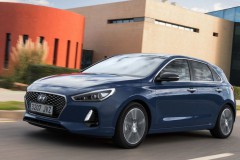Hyundai i30 2016 N Performance 2.0 T-GDI
Hyundai i30 2016 2.0 petrol description
Hatchback Hyundai i30 2016 N Performance 2.0 T-GDI is being produced from January, 2017. It has four-cylinder petrol engine with displacement of 2.0 litres, which produces power of 275 horsepower on 6000 rpm - this is the most powerfull Hyundai i30 2016 version and torque 353 Nm (Newton metres) on 1450 revolutions per minute.
This 4-cylinder 16-valve engine camshaft is driven by chain (What is an engine chain and belt? ). Engine has fuel injection system without turbocharger. Engine versions compliant with Euro 5 and Euro 6 emission standards available.
More engine specs
This Hyundai i30 2.0 engine oil type is 5W-20, 5W-30 and oil capacity is 6.1 litres.
Hyundai i30 2016 N Performance 2.0 T-GDI has front wheel drive (FWD) and manual gearbox with 6 gears.
Hyundai i30 2016 N Performance 2.0 T-GDI accelerates to speed 100 kilometres per hour in 6.1 seconds. The maximum speed of this car is 250 km/h.
The fuel consumption of this version of Hyundai i30 2016 N Performance 2.0 T-GDI reported by owners in daily driving mode is 9.3 litres per 100km.
Hyundai i30 safety
During safety testing Hyundai i30 has obtained 5 stars from five, which means very high safety level.
Adults (driver and passenger) safety of Hyundai i30 is evaluated with very good rate 88 from 100, children safety: very good mark - 84 from 100, for pedestrian protection Hyundai i30 got 64 points from 100.
Hyundai i30 safety equipment has been rated as average - 68 percents from 100.

Hyundai i30 2016 N Performance 2.0 T-GDI technical data
| Model: | Hyundai i30 N Performance 2.0 T-GDI | ||
|---|---|---|---|
| Body style: | Hatchback | ||
| Production period: | 2017. January | ||
| Engine: | 1998 cm3 Petrol, 4 cylinders | CO2 emissions: | no data |
| Power: | 275 HP ON 6000 RPM | Torque: | 353 NM ON 1450 RPM |
| Gearbox: | Manual gearbox (6 gears) | Drive type: | Front wheel drive (FWD) |
| Maximum speed: | 250 km/h | Acceleration 0-100 km/h: | 6.1 seconds |
| Fuel consumption: | 9.3 l/100km (25.3 MPG) by user reviews from various sources | ||
| Fuel tank capacity: | 50 litres (13.2 gallons) | ||
| Car dimensions: | 4.34m (length) 1.80m (width) 1.45m (height) | ||
| Turning diameter: | 11.6 meters | ||
| Trunk capacity: | 395 litres | ||
| Trunk max capacity: | 1301 litres (with rear seats folded down) | ||
| Gross weight: | 1950 kg | ||
Hyundai i30 2016 N Performance 2.0 T-GDI engine G4KH
| Engine displacement | 1998 cm3 |
|---|---|
| Number of cylinders | 4 |
| Bore (cylinder diameter) | 86 mm |
| Stroke length (piston move) | 86 mm |
| Compression ratio | 9.5 : 1 |
| Camshaft drive | Timing chain Chain motors are considered more reliable, chain replacement usually is required less often than a timing belt, but they are often louder and vibrate more. More service info |
| Timing chain change interval | 120,000 km (recommended) Sometimes manufacturers do not specify timing chain replacement intervals and design chains for engine life. However, once the recommended change interval has been reached, it is recommended to periodically check the condition of the chain and to change the chain if excessive stretching is detected or if unusual noises from the engine or other symptoms occur. |
| Fuel system | Injection |
| Hyundai i30 2016 N Performance 2.0 T-GDI oil type | 5W-20, 5W-30 |
| Oil capacity | 6.1 litres (6.4 quarts) More service info |
| Power | 240 - 280 HP ON 6000 RPM |
| Torque | 353 - 365 NM ON 1450 RPM |
| Start of production (year) | 2010 |
| Duration of production | 14 years |
| Engine also used on | Hyundai Santa FE Kia Sportage Hyundai Sonata Kia Sorento and 3 other models |
Generally, the use of an engine in several models and its long production run is an indication of the quality of the engine and the success of its design. |
All Hyundai i30 hatchback [2016 modifications
| Modification | Engine | Power | Consumption | Gearbox |
|---|---|---|---|---|
|
Hyundai i30 2017 1.0 T-GDi
Jan 2017 — Most fuel efficient petrol version |
1.0 Petrol | 120 HP | 4.5 l/100km | Manual (6) |
| Hyundai i30 2016 1.4 MPi | 1.4 Petrol | 100 HP | - | Manual (6) |
| Hyundai i30 2017 1.4 T-GDi Jan 2017 — | 1.4 Petrol | 140 HP | 4.8 l/100km | Manual (6) |
| Hyundai i30 2017 1.4 T-GDi Jan 2017 — | 1.4 Petrol | 140 HP | 5.2 l/100km | Automatic (7) |
|
Hyundai i30 2017 1.6 CRDi
Jan 2017 — Most fuel efficient diesel version |
1.6 Diesel | 110 HP | 3.4 l/100km | Manual (6) |
|
Hyundai i30 2017 1.6 CRDi
Jan 2017 — Most fuel efficient diesel version by real consumption |
1.6 Diesel | 110 HP | 4.0 l/100km | Automatic (7) |
|
Hyundai i30 2016 1.6 CRDi
Most powerfull diesel version (136 HP) |
1.6 Diesel | 136 HP | - | Manual (6) |
|
Hyundai i30 2016 1.6 CRDi
Most powerfull diesel version (136 HP) |
1.6 Diesel | 136 HP | - | Automatic (7) |
| Hyundai i30 2017 N 2.0 T-GDI Jan 2017 — | 2.0 Petrol | 250 HP | - | Manual (6) |
|
Hyundai i30 2017 N Performance 2.0 T-GDI
Jan 2017 — Most dynamic version - 100 km/h in 6.1 seconds |
2.0 Petrol | 275 HP | - | Manual (6) |
